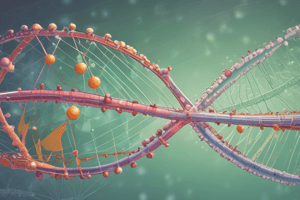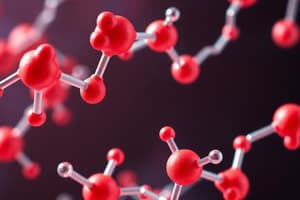Podcast
Questions and Answers
What is the primary purpose of using Allele-Specific Oligonucleotide (ASO) Dot Blot?
What is the primary purpose of using Allele-Specific Oligonucleotide (ASO) Dot Blot?
- To detect gene expression levels
- To find Single Nucleotide Polymorphisms (SNPs)
- To identify Sickle Cell Anemia (correct)
- To hybridize labeled target DNA
What does Reverse Dot Blot involve?
What does Reverse Dot Blot involve?
- Binding DNA to a membrane
- Measuring gene expression levels
- An array of ASOs hybridized to target DNA (correct)
- Isolation of patient's DNA
How frequently do Single Nucleotide Polymorphisms (SNPs) occur in the human genome?
How frequently do Single Nucleotide Polymorphisms (SNPs) occur in the human genome?
- Every 100-300 bp
- Every 250-500 bp
- Every 10,000 bp
- Every 1,000-3,000 bp (correct)
What is one reason that most SNPs have no effect on phenotype?
What is one reason that most SNPs have no effect on phenotype?
What is the role of microarray technology in cancer research?
What is the role of microarray technology in cancer research?
During microarray analysis, what indicates that a patient's DNA has a particular mutation or SNP?
During microarray analysis, what indicates that a patient's DNA has a particular mutation or SNP?
What does a laser scanner measure in a microarray analysis?
What does a laser scanner measure in a microarray analysis?
What collaborative initiative was formed by pharmaceuticals to advance research on SNPs?
What collaborative initiative was formed by pharmaceuticals to advance research on SNPs?
What is a primary benefit of using molecular diagnostics?
What is a primary benefit of using molecular diagnostics?
What type of testing involves sampling at 8 to 10 weeks for chromosome abnormalities?
What type of testing involves sampling at 8 to 10 weeks for chromosome abnormalities?
Which molecular technique uses fluorescence probes that are specific for chromosomes?
Which molecular technique uses fluorescence probes that are specific for chromosomes?
What genetic mutation is directly detected through RFLP in sickle cell disease?
What genetic mutation is directly detected through RFLP in sickle cell disease?
In the context of hybridization in molecular diagnostics, what is the target?
In the context of hybridization in molecular diagnostics, what is the target?
What is a primary use of dot blots in genetic diagnostics?
What is a primary use of dot blots in genetic diagnostics?
Which statement correctly describes the role of a probe in hybridization?
Which statement correctly describes the role of a probe in hybridization?
What method cuts DNA at specific sites to detect mutations like in sickle cell disease?
What method cuts DNA at specific sites to detect mutations like in sickle cell disease?
Flashcards
Molecular Diagnostics
Molecular Diagnostics
A type of molecular diagnostics that uses DNA, RNA, and proteins to identify and diagnose diseases, monitor treatment response, and predict disease outcomes.
Restriction Fragment Length Polymorphism (RFLP)
Restriction Fragment Length Polymorphism (RFLP)
A technique that uses restriction enzymes to identify specific DNA sequences, which can be used to detect mutations or polymorphisms.
Sickle Cell Mutation
Sickle Cell Mutation
A mutation in the beta-globin gene that causes sickle cell disease, resulting in a change in the amino acid sequence of hemoglobin.
Hybridization
Hybridization
Signup and view all the flashcards
Dot Blot Assay
Dot Blot Assay
Signup and view all the flashcards
Fluorescence In Situ Hybridization (FISH)
Fluorescence In Situ Hybridization (FISH)
Signup and view all the flashcards
Amniocentesis
Amniocentesis
Signup and view all the flashcards
Chorionic Villus Sampling (CVS)
Chorionic Villus Sampling (CVS)
Signup and view all the flashcards
ASO Dot Blot
ASO Dot Blot
Signup and view all the flashcards
Reverse Dot Blot
Reverse Dot Blot
Signup and view all the flashcards
Single Nucleotide Polymorphism (SNP)
Single Nucleotide Polymorphism (SNP)
Signup and view all the flashcards
Microarray Technology
Microarray Technology
Signup and view all the flashcards
Microarray analysis for Disease Gene Identification
Microarray analysis for Disease Gene Identification
Signup and view all the flashcards
Microarray
Microarray
Signup and view all the flashcards
Bioinformatics
Bioinformatics
Signup and view all the flashcards
Microarray Technology for Gene Expression Analysis
Microarray Technology for Gene Expression Analysis
Signup and view all the flashcards
Study Notes
Introduction to Bioinformatics
- Bioinformatics applies statistics and computer science to molecular biology.
- It's used to organize biological data and extract relevant information.
Detecting Genetic Diseases
- Fetal testing:
- Amniocentesis (16 weeks) - karyotype test
- Chorionic villus sampling (8-10 weeks) - karyotype test
- Testing for chromosome abnormalities and defective genes:
- Fluorescence in situ hybridization (FISH) uses probes specific to chromosomes/genes.
- Spectral karyotype analysis analyzes chromosome structure.
Molecular Diagnostics
- Uses DNA, RNA, and proteins to detect, diagnose, subclassify, predict, and monitor disease response.
- This field improves disease detection sensitivity, specificity, and analysis speed.
- It's a cost-effective method.
Molecular Diagnosis of Sickle Cell Disease (RFLP)
- A specific hemoglobin mutation.
- RFLP (Restriction Fragment Length Polymorphism) identifies mutations.
- Uses wild type and mutant examples.
- Differs from the normal hemoglobin by an amino acid change.
Hybridization
- Single-stranded oligonucleotides create hybrids based on complementary sequences.
- Target sequences are matched by oligonucleotides.
- Probes are nucleic acids with markers for detection.
Dot Blots
- Assesses SNPs (single nucleotide polymorphisms) using PCR-amplified DNA.
- DNA is blotted onto a membrane, then unbound probes are washed.
- Bound probes are detected via radioactive or colorimetric means.
Allele-Specific Oligonucleotide (ASO) Dot Blot
- Detects sickle cell anemia via ASOs.
- Different DNA sequences are visualized as different intensities.
Reverse Dot Blot
- ASOs are bound to a membrane instead of DNA.
- Labeled target DNA hybridizes to the bound ASOs.
- Useful for analyzing genetic profiles.
Single Nucleotide Polymorphisms (SNPs)
- Common genetic variations.
- One SNP occurs approximately every 1,000-3,000 base pairs in the human genome.
- Most have no effect as they occur in non-coding regions (introns).
- SNPs contribute to pharmaceutical development (SNP Consortium).
Microarray Technology
- Compares gene expression levels in different tissues.
- Used in cancer research for comparing diseased and healthy cell gene expression.
- DNA from a patient is isolated, labeled, and hybridized to the microarray.
- Laser scanning measures the intensity of fluorescence.
Genome-Wide Association Studies (GWAS)
- Based on scoring genomic DNA from a large sample of cases and controls using single nucleotide polymorphisms (SNPs).
- Comparing frequencies of SNPs between cases and controls helps identify significant differences.
- Results are validated from independent samples.
The HapMap Project
- Public database with more than a million common variants (SNPs) in the human genome.
- Based on typing 269 DNA samples from different populations.
Basic Bioinformatics Data
- Genomics is the study of genomes.
- Genomics results from the dramatic rise in the scale of biological data collection.
- Sequencing.
- SOAP alignment.
- SNP detection and annotation.
- InDel detection and annotation.
- SV (structural variation) detection and annotation.
- CNV (copy number variation) detection and annotation.
Basic Bioinformatics Analysis
- Ancestry analysis.
- HGMD (Human Gene Mutation Database) analysis.
- Haplotypes construction.
- Demographic analysis.
- Evolution analysis.
Genome de novo Sequencing using NGS (Next-Generation Sequencing)
- Sequencing technology used for genome-wide sequencing.
- Processes include fragmenting, sequencing, and assembling DNA.
Bioinformatics Databases
Common databases for biological information.
- GeneBank/DDBJ/EMBL (nucleotide sequences)
- Ensembl (genomes of human/mammals)
- PubMed (literature references)
- Swiss-Prot (protein sequences)
- OMIM (genetic diseases)
Broad Goal of Genome-Wide Association Studies (GWAS)
- To find genetic markers associated with specific traits/diseases.
- To find markers in the genome that correlate significantly to phenotypes.
Why Study Genetic Differences?
- Prediction of adult features from a child's genetics.
- Development of gene therapies for genetic diseases.
- Creation of disease-resistant strains in agriculture.
- Understanding disease frequencies in different populations.
Studying That Suits You
Use AI to generate personalized quizzes and flashcards to suit your learning preferences.




